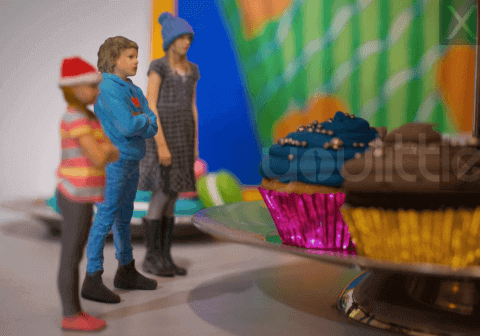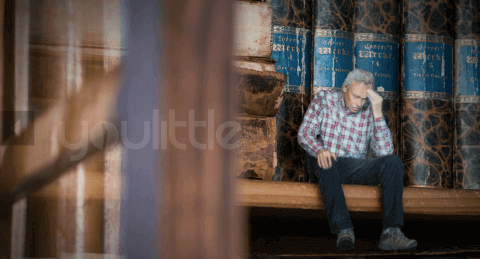Who are youlittle’s customers?
Anyone who is looking for a special gift, for example families wanting to give their grandparents a statue of their grandchildren. We also get couples who would like to commemorate their anniversary in a special way. We’ve also scanned pets and we even once scanned a firefighter in his complete turnout gear – he looked fantastic! He had told us that he was approaching the end of his firefighting career … and, of course, he wanted something to serve as a lasting memory of it.

What do I have to keep in mind if I want to have a 3D portrait of myself made?
Not a whole lot, actually the only really important thing is the clothing. A sleek black suit makes the final finishing process more difficult; the 3D model might have holes in it that then have to be covered over by hand. Shiny, glossy or reflecting fabrics and accessories might also negatively affect the results.
That’s why I give my customers a few tips on what to wear over the phone before they come in to be scanned. It’s also a good idea to think beforehand about what pose you want to take – just like with a photograph there’s no changing that afterwards. The subject is photographed simultaneously using 48 cameras, so just about any pose is possible … you can stand on one leg, do a handstand, even move around. The cameras are briefly triggered, then there’s a flash and the 3D photo is finished.
“Basically the technology operates in the same way as an ink jet printer – except that it’s in 3D”
What material is used for printing?
We print using polymer gypsum, which is a mixture made up of gypsum and ceramic powder. The same technology is used industrially to construct prototypes and architectural models. The biggest advantage here lies in the fact that our machines can produce 3D models in full color.
Are pigments added?
Yes, basically the technology operates in the same way as an ink jet printer. The color is applied to the gypsum particles through fluid tips during the printing process, which entails placing extremely thin, one tenth of a millimeter layers on top of each other. The color is applied to the outside of each layer as it is laid and extends inwards about one millimeter from the outer edge – on the inside the statue remains white.
What do you have to keep in mind during the finishing process?
The final finishing is crucial. For this I use several different programs. To begin with I compile the photographs into a rough geometric 3D model. In the next step I put on the finishing touches using a second program – this involves smoothing over rough spots and filling holes in the model. Using yet a third program I modify the colors, textures and the surface of the model in order to make it look as realistic as possible. Sometimes it’s necessary to run it through all three steps again … however long it takes to achieve a perfect result.
How much time does all this take?
If everything goes well, two to three hours. Sometimes I spend half a day or longer working on a particular 3D model – depending on how intricate the pose is. Once we scanned two people at the same time; that can make the finishing process somewhat tricky, because the two bodies partially cover each other up. In this case I had to remodel some of the gaps between them.
“Generally we try to keep the figures as lifelike as possible”

What about things like six-packs and touch-ups? Do people often ask for that?
If a customer wants the statue to have slenderer hips or a flatter stomach then we can do that, too. That isn’t often asked for, however. Generally we try to keep the figures as lifelike as possible – after all, the customers should be able to recognize themselves. Their statues should have the same appearance as they did upon entering the studio – that’s when the results really bowl them over.
Where did you get the idea to provide a 3D service for selfies?
I saw a report on TV about a Japanese firm (Omote3D, editor’s note) that was offering 3D portraits in Tokyo. That made me curious, so I started looking into it – into how 3D printing works, what possibilities it offers and in what cities such services were already being provided. Seeing as there still weren’t any comparable providers in Munich I made use of the opportunity. My actual profession is graphic and motion design, so I was already somewhat acquainted with 3D graphics and processing, but I’ve learned a lot more through my experience with youlittle.
What do you call this service that you’re offering?
“We print you – in 3D!” The field still hasn’t come up with a standard designation for it. People are using names like 3D-figure, 3D-miniature, 3D-sculpture, Mini-Me … you have to pay close attention to what key words potential customers are running searches on in order to make sure that you’re using the right catchphrases.
Is it possible to print a 3D model with other materials, as well?
Anything that exists as a 3D model in a computer can be printed. We use a gypsum polymer printer, but one can also print out models in plastic or metal. Once you have the model it can also be printed out in other materials.
How does one judge the quality of a 3D selfie?
First of all, you have to get every detail right. You can judge that by looking at the facial features, the folds of the clothing, the surface texture – if everything looks real, then the quality is up to par. Then the print itself is important – if it doesn’t turn out well one sees it right away. If you’re using a polymeric printer you’ll notice immediately if the colors and the resolution are off – the details won’t be visible. And finally, putting time into the final finishing and making an extra effort there will pay off well for you. You can crank out a 3D model within half an hour, but the final product won’t look very good.
(Oliver Frank was interviewed by All3DPs Co-Founder Anatol Locker)
License: The text of "“Our customers are looking for a special gift”" by All3DP is licensed under a Creative Commons Attribution 4.0 International License.